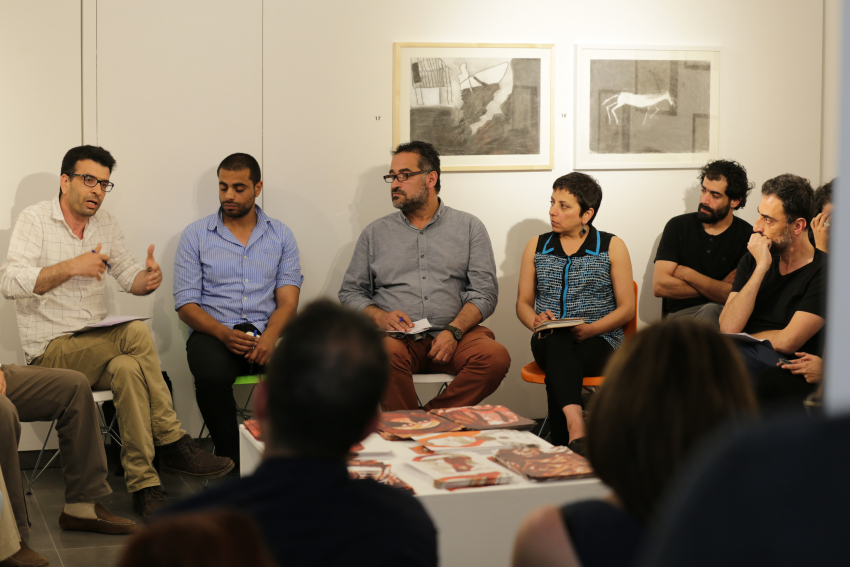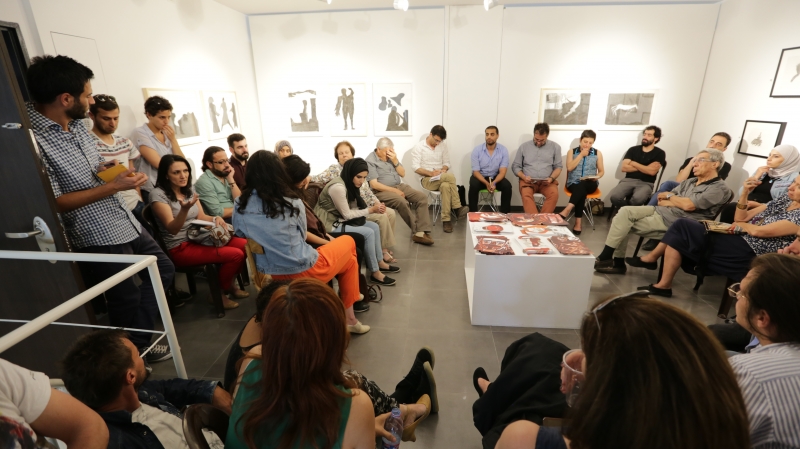
The AMQF Public Programme held a seminar on the Daydream Silhouettes performance, in cooperation with Gallery One and the Live Action Role Play Group (LARP). The performance had been developed by the Public Programme’s Groups Programme with an aim to raise a number of questions about the art scene in Palestine.
LARP, which groups a number of improvisational actors, worked with AMQF to create a make–believe art exhibition that simulated the conditions of real art exhibitions. Participants built a fake artist biography, produced false artworks, displayed them in the exhibition space, and finally, interacted with the public during the opening ceremony.
Daydream Silhouettes opened on Wednesday, May 3, 2017 in Gallery 1. A number of art amateurs and artists attended the opening.
Participants at the seminar included artist Khaled Hourani, Samar Martha, Director of Gallery One, Mahmoud Abu Hashhash, Director of the Culture and Arts Programme at AMQF, Louay Misleh, LARP Representative and Yazid Anani, Director of the Public Programme.
During the seminar, Anani explained that the work was experimental and involved a number of errors. He added, “In this experience, we tried to understand the public’s reaction and to raise a number of questions, initiated by LARP, around art criticism and evaluation, especially when educational institutions, critics and art magazines lack or fail to talk about art fundamentals and history”.
Furthermore, Louay Musleh gave a short introduction of LARP, which had the chance to present its first public interactive show through Daydream Silhouettes. “We write stories, tackle a particular situation or event, then transform that into a play – no audience, directors or cameras,” Musleh explained. He added, “The goal is to open our work to the public, ask questions and criticize certain practices on the art scene, including those of art connoisseurs”.
Artist Khaled Hourani noted that creating debate around art is a sign of its dynamism, which is an important subject that needed to be discussed one way or another. Hourani then raised a number of questions around the performance experience of LARB, including the following ones: “Is art (and exhibitions) in Palestine a subject really worthy of discussing at this scale? Is it really an all-encompassing artistic phenomenon, with its collectors and galleries, or one that that needs much support? Are the public, critics and collectors the ones to be questioned, or should it rather be organizations and galleries?” Hourani added, “I expect this dialogue to be more effective when more ‘victims’ are present, including Qattan and Gallery One, especially due to their role in creating and promoting art”.
“We in Qattan are constantly receiving requests from artists to produce exhibitions,” Abu Hashhash later commented. “We find ourselves in a dilemma; that is, because in the case of some artists, we can immediately come to a decision about the works. But at other times, we hesitate or feel wary to judge the submitted work too hastily. I think the task has become much harder nowadays. It certainly requires dialogue.”
About the Gallery One experience, Samar Martha said, “We wanted to work with a group of young people and raise with them a number of questions.” She continued, “I believe that art galleries must have other roles to play on the art scene, so they can be part of the dialogue. Rather than a mere exhibition space, a gallery should also be a space for experimentation and criticism, for holding symposiums and events and attracting new audiences”.

After the participants’ keynotes, a number of questions were raised and a discussion took place – some attendees had favorable views on the overall Daydream Silhouettes experience, others criticized it from a number of angles.
“This show raises questions and calls for thought about the nature of art, among other things,” said artist Anani. Some expressed opposing views, including Rula Dughman, an art gallery owner. She said, “I couldn’t understand the point of this performance. I realize that it is a personal experience to you and that you have asked feedback from artists, but you have failed to think about the other group, which is more important in my opinion – the ordinary people. Most galleries struggle to reach them and develop their art knowledge. I believe, with this show, you have caused them shock and led them to question the relevance of art.”
